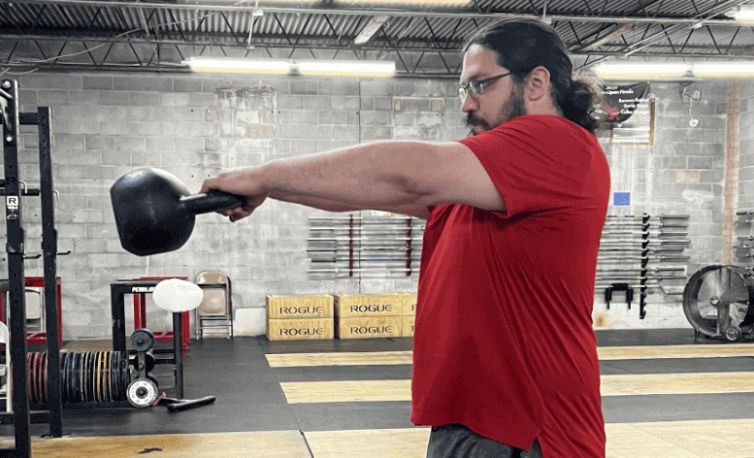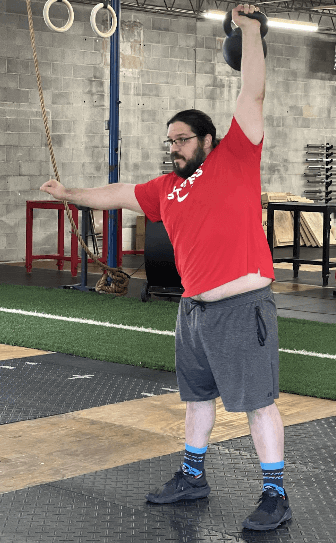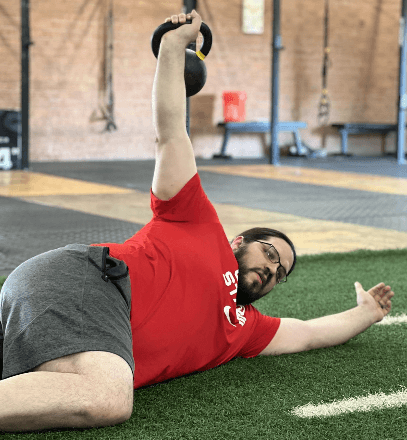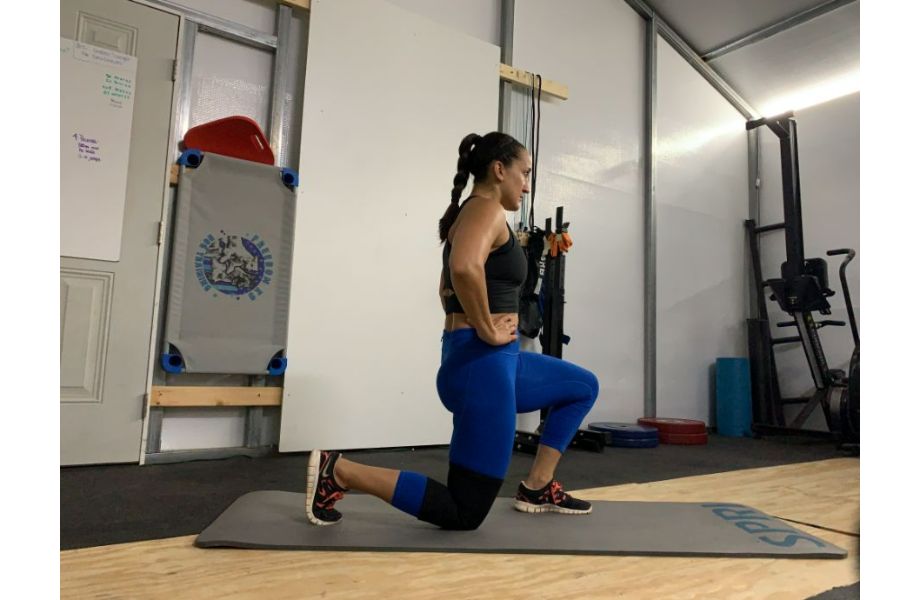We test and review fitness products based on an independent, multi-point methodology. If you use our links to purchase something, we may earn a commission. Read our disclosures.
As an Olympian and competitive weightlifter, I compete in two barbell movements: the snatch and the clean-and-jerk. All my training is focused on improving these movements, but not all of my training can be built from just two movements and a barbell. There are many tools and many ways to diversify my training, but nothing compares to the utility of a kettlebell.
For me as an athlete, the kettlebell is a way to fill the gaps in my typical workout, rounding out my accessory work with unilateral training that isn’t typical in traditional barbell movements. As a coach, I see kettlebell exercises as a method to improve my athletes’ power and body strength, and awareness in multiple ways. Your experience level doesn’t matter; whether you’re an elite weightlifter or a novice fitness enthusiast, kettlebell benefits are numerous and immeasurable.
Let’s talk about how this ball of cast iron with a handle can benefit your training.
1. Gives You a Low-Impact Workout
Kettlebell training is going to provide less wear-and-tear on the joints than many other exercises. Although they deal with developing power and explosive strength, kettlebell exercises remain low-impact, as they are done with the feet remaining on the floor. This keeps you from over-straining the joints, tendons, and ligaments during your workout.
The loads are also going to be lighter than most barbell training while still providing a challenge. I have clean-and-jerked more than 500 pounds in my lifting career and still have trouble maintaining my balance on a single-leg deadlift with anything over 35 pounds (don’t laugh!). Kettlebells provide a challenge in other aspects of fitness, such as balance and coordination, without the heavier weights of barbell training.
2. Versatile and Space-Efficient Equipment
This simple piece of equipment will fill that void in any training regiment. Need to develop explosive strength and power? Try some kettlebell swings. Want to build strength in the upper and lower body? Then try some presses and goblet squats. Even beyond that, abdominals and stabilizers can be attacked with a total-body exercise like Turkish get ups. The options for exercise provided by a kettlebell can address virtually any area in your fitness endeavors.
Along with being versatile, a kettlebell is compact and portable. It takes up the same amount of space as a dumbbell or cannonball, and most exercises require very little space. This makes a kettlebell an ideal training tool for a lifter on-the-go: small enough to fit into any home studio or garage gym, and portable enough to take outdoors, or anywhere, really!
3. Provides a Full-Body Workout
Kettlebells can improve all aspects of fitness; from balance to strength, to cardio, and even to flexibility and mobility. Furthermore, kettlebell exercises often bombard the entire body and major muscle groups, providing a full-body workout.

The kettlebell swing attacks the entire posterior chain: glutes, hamstrings, and lower back. Another explosive movement, the kettlebell clean-and-jerk, gets the entire body involved, from the legs and hips to the overhead motion of the shoulders and arms. Along with explosive movements, kettlebells can get the whole body involved in purposeful, deliberate exercises. Movements like goblet squats, lunges, and presses all are slower movements that focus on building strength, while also demanding the use of stabilizers and the core.
Whether a powerful, fast movement or a slow one, kettlebells provide that full-body workout that gym-goers aim for.
4. Builds Muscle
A high-intensity kettlebell workout will help build lean muscle mass on any athlete. Weighted anaerobic movements performed with lots of repetitions will provoke the muscular adaptation to grow lean, tight muscle tissue. And whatever your goals, more muscle tissue will mean bigger strength gains.
RELATED: Our top picks for the best adjustable kettlebell
5. Builds Cardiovascular Endurance
Not many people think about the cardiovascular benefits of weight training, but kettlebells are great in boosting your cardio. The submaximal loads of a kettlebell allow for the athlete to move quickly through repetitions. Also, kettlebell circuits tend to be short, intense workouts, giving you that cardiovascular response from the high repetitions in a short time frame.
A 2014 study showed that high-intensity kettlebell training demonstrated an increased cardiovascular response when compared to traditional training. You can get a great cardio workout from kettlebells without the impact or timeframe of running hours on end.
6. Builds Core Strength
Whether a slow or ballistic movement, kettlebells demand a lot of stability and strength in the core of an athlete.
One of the best kettlebell exercises (and one of my favorites) is a Turkish get-up; this movement is a slow movement from standing to lying down and back up again, all while keeping a single kettlebell up and overhead throughout the movement. The entire body from head to toe is recruited for this movement, and it requires strength not only in the arms and legs, but a strong core as well.
Kettlebells are helpful in developing a strong core because kettlebell exercises are unilateral in nature: one kettlebell is used in one hand, causing the core to have to fight against the shifted weight load. Exercises like the Turkish get-up and kettlebell snatch constantly address core stability.
7. Builds Grip Strength
It’s worth mentioning the proven grip strength that kettlebells develop. Holding onto an odd object for reps without rest gives your grip an intense challenge across different movements.

Additionally, the change in grip pressure throughout a movement, like a clean, can also develop strength in the grip, as well as an awareness and control over grip strength. In the clean, the angle of the hand in relation to the kettlebell changes drastically from the finish of the pull to the catch of the clean; this will not only boost your grip strength, but also teach you the body awareness of your grip throughout an exercise.
Grip strength is vital for me as a weightlifter. A stronger grip means a stronger pull off the floor, vital in Olympic lifting. Kettlebells can help with that pulling power and strength.
8. Corrects Muscle Imbalances
As an elite weightlifter, I’ve had my fair share of muscle imbalances over years of strength training. While there are many ways to address these issues, kettlebells have a natural tendency to help work out imbalances.
As stated before, kettlebell exercises are unilateral movements, which will allow you to address a weaker side of the body. When I feel like I’m favoring one leg or hip in my squat, I’ll address it with single leg deadlifts or lunges.
Kettlebells and their exercises help supplement any muscle weaknesses, helping strengthen weaker muscle areas, and helping you get to a more balanced, more powerful, stronger you!
RELATED: The battle of dumbbell vs kettlebell
9. Improves Balance and Flexibility
According to this 2013 study, the benefits of kettlebell training were proven to not only be building strength, but also developing balance. The majority of exercises are multiplanar by design, challenging the athlete to maintain balance through multiple ranges of motion. These exercises help build a solid foundation of balance and mobility.

Also, certain exercises will develop range of motion and flexibility. A goblet squat is a simple way to test and measure the flexibility of the hips, while also challenging the athlete to sink lower in the squat while maintaining proper form. By working on range of motion in these workouts, you will be able to develop the mobility and flexibility to execute these movements effectively.
10. Builds Power
In Olympic weightlifting, the snatch and clean and jerk are tests of power and explosive strength. Because of this, kettlebells are proven to be a great supplement to Olympic weightlifting and other sports in that they develop power as well.
Most kettlebell movements require you to drive a weight in a short time for multiple reps. For me, the kettlebell is a great way to continue developing power and train unilateral movements, all while at submaximal loads. Still, this power development will benefit all levels of athleticism.
11. Burns Calories
Kettlebells have been shown to burn calories comparable to running a 6-minute mile. In addition, the heart rates of participants were actually higher in kettlebell training versus cardio training. This is due to the full-body, high-intensity workout style that kettlebells lend themselves to.
This all shows that high reps at a high intensity, such as with kettlebells, can be one of the best ways for a calorie burn and weight loss in your health journey.
Who Should Do Kettlebell Training?
I would recommend kettlebells to all fitness levels. For a power athlete like myself, kettlebells can address imbalances and build core and grip strength, while never taking the focus off of developing power. For any strength athlete, this is a good tool to address conditioning with high-intensity training, all while addressing other aspects, like coordination and balance.
Kettlebells are great for newcomers as well, because of the wide berth of benefits that kettlebells have. From building core or functional strength to developing balance, coordination, or flexibility, to getting more powerful and athletic. No matter where you start, kettlebells can help address your weaknesses.
How to Incorporate Kettlebell Movements Into Your Training
There are a few ways you can bring kettlebell exercises into your routine.
In Your Warmup
I use light kettlebells in my warmups to help activate muscle groups before training. It’s best to use lighter weights and controlled movements to prime muscles as well as movement patterns without overdoing it. I like to perform single-leg deadlifts to get my glutes and posterior chain firing properly, as well as armbars to warm up the shoulders.
As a Cardio Finisher
Another way to incorporate kettlebells into your programs is through HIIT training. One way I get a cardiovascular response quickly is a tabata workout: 20 seconds of work followed by 10 seconds of rest.
Hitting a tough, high-intensity workout like this with some Russian kettlebell swings or clean-and-jerks gets the muscles fired up and elevates the heart rate to burn some calories. Make sure to keep the kettlebell weight manageable in order to move quickly throughout. The fast pace of a CrossFit workout can also get the heart pumping.
As Accessory Work
Accessories are vital to supplement training for correcting imbalances, strengthening weaknesses, and becoming a well-rounded athlete. A lot of the kettlebell work I do to supplement my weight training involves attacking and strengthening the core. Full-body exercises like Turkish get-ups are hugely helpful in my training. I also do side bends to approach the abdominals; even presses help in getting some unilateral training, strengthening smaller stabilizer muscles throughout the motion.
FAQs About Kettlebell Benefits
What do kettlebells do for your body?
Kettlebells get the whole body involved with minimal stress on the joints. The American Council on Exercise stated that not only does a kettlebell workout routine build strength, but also aerobic capacity, core strength, and balance, all of which are vital in any training program. Different movements help develop an athlete’s strength from head to toe, but particularly in the core and grip. Finally, it can help correct muscle weaknesses and imbalances. The benefits of kettlebell training are undeniably numerous and vast.
Is a kettlebell workout effective?
Kettlebell workouts are effective in that they offer a versatile experience. Within a short period of time, you can get a good cardio burn while building strength and muscle at the same time. The variety of exercises help achieve a full-body workout. They are very efficient in providing a lot of benefits in a short workout time, which is ideal for many adults constantly on the move.
Are kettlebells good for losing belly fat?
Kettlebells are great for burning calories and building muscle. Burning calories can help with losing fat, but they will not help you to lose it anywhere in particular. Spot reduction, or targeted fat loss on certain parts of the body, is a myth that stems from the thought that targeting training abdominal muscles will help reduce abdominal fat. This simply is not true. While you can build muscle and burn calories, there is no proven way to target fat loss in the belly, or any area of the body specifically.
Kettlebells are an extremely efficient way to help add variety and effective training to your program with just a single ball of iron. I’ve used it throughout my lifting career, and I’d recommend its use to everyone. So get out there and try this neat piece of equipment.
Further reading

Need help deciding how to choose an exercise bike? We’ve got you covered with all you need to know. Read more

As an Olympian and competitive weightlifter, I compete in two barbell movements: the snatch and the clean-and-jerk. All my training is focused on improving these movements, but not all of my training can be built from just two movements and a barbell. There are many tools and many ways to diversify my training, but nothing compares to the utility of a kettlebell. For me as an athlete, the kettlebell is a way to fill the gaps in my typical workout, » Read more about: 11 Kettlebell Benefits, According to an Olympian » Read more

All of the usual benefits of working out apply to partner workouts, but working out with someone else comes with a few unique perks. Read more

Struggling to build muscle without equipment? Try this bodyweight leg workout! Read more
